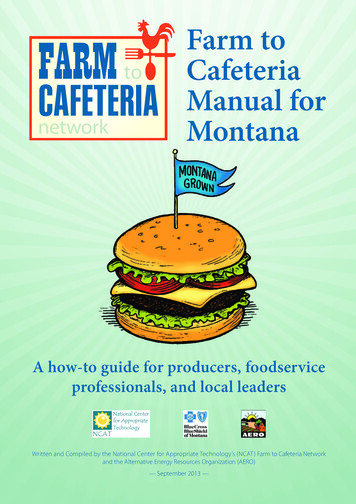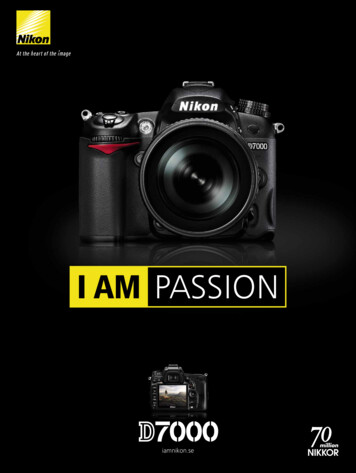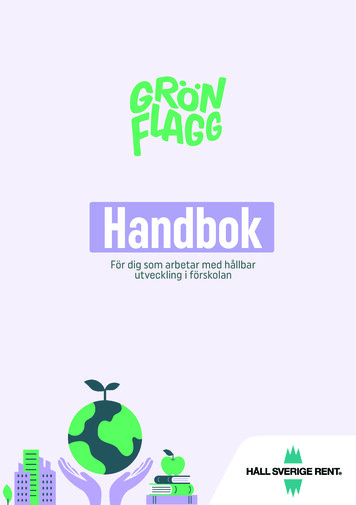
Transcription
A how-to guide for producers, foodserviceprofessionals, and local leadersWritten and Compiled by the National Center for Appropriate Technology’s (NCAT) Farm to Cafeteria Networkand the Alternative Energy Resources Organization (AERO)— September 2013 —
Farm to Cafeteria Manual for MontanaPublished by the National Center for Appropriate Technology (NCAT)August 2013 NCATPrimary AuthorNancy Moore, M.S.NCAT Program SpecialistFarm to Cafeteria Network CoordinatorDesign and LayoutAmy Smith, NCAT Graphic DesignerRobert Armstrong, freelance cartoonistContributing Writers and EditorsKevin Moore and Lyra Leigh-Nedbor,Alternative Energy Resources Organization (AERO)Crissie McMullan, Jeff Birkby, and Cathy Svejkovsky,NCAT Program SpecialistsAubree Roth, Montana Team NutritionContributing OrganizationsBlue Cross Blue Shield Foundation for Healthy MontanansMontana State University ExtensionAlternative Energy Resources Organization (AERO)Additional ThanksThere were many farmers, food processors, government officials,foodservice directors, nonprofit staff, and community members who providedfeedback and insight about the content of this manual.Thanks for your help, and for all the work you do for Montana’s food system.
Table of ContentsIntroduction . 4About This Manual .4What is Farm to Cafeteria? .4Goals and Benefits of Farm to Cafeteria Programs .4Montana-Specific Considerations .5Section I: For Farmers and Ranchers . 7Why Should I Get Involved in Farm to Cafeteria? .7Overview of Institutional Markets and Special Considerations for Each .7Strategies for Selling to Institutions .11Food Safety Considerations .14Section II: For Foodservice Professionals . 19Why Create a Farm to Cafeteria Program in My Institution?.19Models of Farm to Cafeteria .20How Can I Find Local Products? .21How Can I Serve Local Food Year-Round? .23Ten Tips for Working with Producers .23Purchasing Agreements .25Marketing Your Farm to Cafeteria Program .25Garnering Support from Administration and Foodservice Staff .26Food Safety Considerations .27Policy Support .29Section III: For Parents, Community Organizers, and Educators . 34Getting Started: How to Bring All the Right People to the Table.34Institutional Food 101: What to Expect When Working with Institutions .35Education and Outreach .37Policy Considerations.39Q & A Session: Kris Thompson of Gallatin Valley Farm to School.41Conclusion . 43Appendices . 44A Seasonal Foods Chart.44B Montana Beef in Schools.45C Checklist for Retail Purchasing of Local Produce .49D Tips for Working with the Press and Sample Press Release .51E Federal Geographic Preference Guidelines.52F Curriculum and Cookbooks.55G Finding Funding .57H Additional Farm to Cafeteria Resources .57ProfilesI. FoodCorps Grows Farm to School Programs .6II. Mission Mountain Food Enterprise Center and Western MontanaGrowers’ Cooperative Lead the Way .15III. Buying Local the “Right Thing To Do” at University of Montana .17IV. Food as Part of Reform in Montana State Prison .31V. Good Food is Growing at Livingston HealthCare .33VI. Red Lodge Area Food Partnership Council and FoodCorps Spur Change .40
IntroductionAbout This ManualThis manual was developed by Farm to Cafeteria Network, a program of theNational Center for Appropriate Technology (NCAT), in collaboration with theAlternative Energy Resources Organization (AERO). Farm to Cafeteria Networkis a group of Montana food producers, processors, foodservice professionals, and community members who collaborate to share best practices and develop resources aboutFarm to Cafeteria programs with the goal of increasing local food in institutions. Youcan learn more about our projects and how to get involved at www.farmtocafeteria.ncat.org.We have designed this manual to be comprehensive, relevant to Montana, and easyto follow. It offers insight and information about how to integrate local foods into yourcafeteria and provides examples of the various models that have been successful. Ifyou have questions or would like more information beyond what is presented here,please get in touch with us by emailing Nancy Moore at nancym@ncat.org or by calling(406) 494-4572.What is Farm to Cafeteria?Farm to Cafeteria can mean different things to different people. In this manual the termFarm to Cafeteria refers to programs in public and private institutions such as schools,colleges, hospitals, correctional facilities, and senior living centers that serve healthy, localfood while engaging the broader community in that effort.Goals and Benefits of Farm to Cafeteria ProgramsThough each Farm to Cafeteria program is unique, they generally share similar values andgoals. Farm to Cafeteria programs often seek to accomplish the following: Provide nutritious, locally-sourced food in cafeteriasSupport local economies by purchasing from regional food producers and processorsReduce greenhouse gas emissions by reducing the distance from farm to tableEducate communities about the value of eating and growing healthy, local foodThe benefits of such programs are numerous and far-reaching.For Farmers, Ranchers, and Food Processors, building a relationship with aninstitution can1.2.3.4.4Diversify your customer baseCreate a stable market for your productsProvide opportunities to engage the community in your agricultural operationProvide a stepping stone into the broader 3 billion food market in MontanaFarm to Cafeteria Manual for Montana
For Foodservice Professionals, buying fresh food from local producers can1.2.3.4.Increase participation in meal programsImprove the taste and quality of your institution’s mealsEarn your institution recognition and bring in new customersProvide more information about the safety and origins of your foodFor Parents, Community Organizers, and Educators, helping build a Farm toCafeteria program in your community can1.2.3.4.Increase community awareness of local farming and food systemsEncourage healthy lifestyles and improve access to fresh, nutritious foodEngage the community in collaborative, hands-on learning experiencesStrengthen local economies and food-based livelihoodsMontana-Specific ConsiderationsMontana’s predominant food system, much like elsewhere in the United States, relies onexporting commodities produced in-state while importing processed foods from out ofstate. There is a strong case to be made that this centralized food system is exacerbating, ifnot creating, health problems and struggling rural communities in Montana. In 2009, theCenters for Disease Control reported that 62% of Montana residents were either overweight (38%) or obese (24%), meaning more than half of Montanans are at increased riskfor heart disease, hypertension, diabetes, and cancer. Meanwhile, the state’s agriculturalsector, capable of providing residents with fresh, healthy foods, is in decline. According toa 2011 study conducted by Ken Meter and funded by the Grow Montana coalition, overhalf of Montana farmers and ranchers report net losses annually.1Local food purchasing is one way to improve the health of individuals as well as revitalizeour agricultural economy. Montana’s public institutions spend approximately 33 millionannually on food purchases.2 Diverting just 20% of that market to local products wouldcontribute an additional 6.6 million to Montana’s agricultural economy, a significantamount of money for small and medium-sized producers looking to enter Montana’slarger 3 billion annual food market.Despite economic struggles, agriculture is still Montana’s largest industry. Beef and wheatgenerally account for three-fourths of all agricultural sales, though farmers and ranchersare increasingly diversifying their crops and operations.3 Other goods commonly produced in Montana include lentils, barley, peas, beets, honey, potatoes, cherries, apples,lamb, oilseeds, dairy products, squash, carrots, onions, cabbage, peppers, and tomatoes.This list is far from exhaustive and new food products are being grown and developedevery year. See Appendix A for a seasonal food chart.1 Western Montana Local Food and Farm Economy, Meter, Ken, 20112 Unlocking the Food Buying Potential of Montana’s Public Institutions, Grow Montana, 20073 Montana Department of Agriculture, 2010Farm to Cafeteria Manual for Montana5
Profile I: FoodCorps Grows Farm to School ProgramsOne of the biggest challenges schools face in sourcing local food is the amountof time and energy it requires. Locating products, coordinating orders and deliveries, and integrating information about those local healthy foods into schoolcurricula—it all takes time.Enter FoodCorps. Launched in 2006 by Grow Montana and the National Centerfor Appropriate Technology (NCAT), FoodCorps began by dispatching AmeriCorps members to Montana towns to help schools buy local food. Since then,the Montana program has grown and served as a model for a national FoodCorps program that took root in 2011.In 2012-2013, service members in ten Montana communities joined a nationalteam of eighty FoodCorps members in twelve states. Their work focuses onthe three FoodCorps pillars: access, which involves helping schools serve local,healthy foods; knowledge, educating students about how and why to eat foodgrown closer to home;and engagement,building and involving students in schoolgardens.The impact has beentremendous. FromAugust 2012 to June2013 FoodCorpsmembers worked withover 7,000 studentsin cooking classes,Montana’s 2012-2013 FoodCorps and AmeriCorps VISTA membersschool gardens, andat a September 2012 Training. Photo courtesy of Lea Howeother hands-on foodactivities. They helped bring over 15,000 pounds of local food into schools withalmost 2,500 pounds coming directly from school gardens. With FoodCorps’ help,schools across Montana have included 81 new ingredients in school menus andare continuing to increase that number.FoodCorps host organizations can be schools, non-profit organizations, orgovernment entities, though all members serve in K-12 schools. Host communities in 2013-2014 are Billings, Kalispell, Boulder, Red Lodge, Ennis, Missoula,Flathead Northshore Area Schools, Butte, Bozeman, and Ronan.To learn more about FoodCorps Montana visit: www.montanafoodcorps.orgTo learn more about National FoodCorps visit: www.foodcorps.org6Farm to Cafeteria Manual for Montana
Although Montana boasts an abundance of raw food products, the state currently lacksadequate food processing infrastructure and facilities. This wasn’t always the case, ashistorically Montana had a very robust processing infrastructure that helped provide70% of Montanan’s diet with local food. As a result, the vast majority of Montana’s agricultural commodities are exported, while grocery stores, restaurants, and institutionsrely on imported foods, often of a lesser quality than what we could grow in-state. Asdemand for local products is increasing, Montana’s ability to process locally is improving, providing yet another opportunity for community-based food systems to supportthe state’s economy.Section I: For Farmers and RanchersWhy Should I Get Involved in Farm to Cafeteria?Montana’s public institutions spend an estimated 33 million on food per year,representing a significant and largely untapped market for Montana’s farmers and ranchers. These institutions can provide a direct market that wouldexpand local food and agriculture businesses, creating economic as well as social effectsthat help revitalize rural communities. When farmers and ranchers develop the capacityto sell to local institutions, they may find that they can better access the broader 3 billion that Montanans spend on food each year, such as in restaurants and grocery stores.In that way, public institutions can provide sales opportunities as well as a great learningopportunity for helping farmers access additional local markets.For farmers and ranchers, building a relationship with an institution can help you createa new and stable market for your business and also provide opportunities for you to engage community members in your agricultural operation. Institutions can act as an idealmarket for “second quality” products (misshapen or slightly bruised, for example) that arejust as tasty as first quality items but more affordable for the institution. The institutionalmarket can also help producers leverage unexpected surplus in a given season or harvestperiod. In addition to second quality and surplus items, many institutions involved inFarm to Cafeteria also purchase normally-priced local food; they have worked hard torearrange their budget so that they can help support farmers like you.Overview of Institutional Markets and SpecialConsiderations for EachMontana has a variety of institutions that serve food such as K-12 schools, public andprivate universities, correctional facilities, healthcare institutions, senior living centers,veterans’ services facilities, preschools, and many more. While there are broad commonalities in the purchasing needs of institutional foodservices, there is also great variation andit is important to understand their different characteristics when considering this marketfor your products.Farm to Cafeteria Manual for Montana7
Institutions generally purchase large volumes of food from a few broadline vendors,such as Sysco or Foodservices of America. Long-term contracts with these vendors ordistributors often require a majority of purchasing through that company. In return, institutions are assured frequent deliveries, fast and convenient ordering, access to nearlyany food product all year-round, and confidence that each product meets all food safetyregulations. They also often get rock-bottom prices. Of course, what they don’t necessarily provide—and where you have an advantage—is food grown nearby, for maximumfreshness and quality. As a farmer or rancher, you should understand that every institutional buyer is different; some will expect consistent, high-volume sales while othersmay be more flexible and willing to accept different items and quantities each week.Regardless of which model you’re working with, the institutional market will likely formonly one part of your diverse marketing strategy.8UniversitiesK-12 SchoolsStudent interest in local food was aninitial driver for what are now broadlysupported Farm to College programsat the University of Montana (UM)and Montana State University (MSU).The university market is perhaps themost flexible of institutional markets;different food venues on campus offerstudent meal plans as well as cash-onlysales, a feature that allows the consumer to absorb increased costs associatedwith local food if any exist. Both UMand MSU facilitate group purchasingamong their branch campuses in thestate and are leaders in purchasinglarge volumes of processed and freshMontana food products through theirbroadline vendor contracts as well asdirectly from area food producers. Several private and community colleges inMontana are also beginning to sourcelocal food and are worth contactingabout potential business.A school district’s size and availablekitchen equipment can greatly affectfood purchasing decisions. In Montana’s rural communities, individualschools often purchase and preparefood in their respective kitchens. Inurban areas, school districts usuallyprepare food in a central kitchen anddistribute it among elementary, middle,and high schools. When making largepurchases, public schools are requiredto hold a bidding process. The geographic preference option can helpfoodservice directors prioritize localsources in that process (see AppendixE for more details). For smaller purchases, foodservice directors must usetheir best discretion and consider fulland open competition in the purchasing process. Most schools receive foodfrom a variety of sources, includingthe federal School Nutrition Programrun by the Montana Office of PublicInstruction and commodity programsrun by USDA. Farm to School programsare increasing in Montana. Check withyour local school district to see if it isalready purchasing from local farmersand businesses.Farm to Cafeteria Manual for Montana
Correctional FacilitiesMontana has seven correctional facilities that collectively spend around 4million on food per year. Most of theseare public institutions that purchasefood through a competitive biddingprocess. The largest correctional facility—Montana State Prison (MSP) inDeer Lodge—is home to the Food Factory, which prepares food served onsite as well for other institutions. MSP isunique for having an inmate-run beefand dairy ranch. Prisons are a marketfor some competitively priced Montanafood products, most likely channeledthrough MSP’s Food Factory.Healthcare FacilitiesFarm to Hospital programs are gainingground nationwide as fresh, local foodplays an increasingly vital role in hospitals’ missions to improve the health oftheir patients. In addition to purchasingand serving local foods, a few Montanahospitals have introduced other innovative models for incorporating localfood in their institutions. One modelis to host farmers markets on hospitalcampuses, while another is to provideemployees with Community SupportedAgriculture (CSA) shares. Unlike schoolsand universities, hospitals, as well asnursing homes and senior living facilities, consistently serve food year-round,including during the peak growingseason, making them a great marketfor local producers. Healthcare facilitiestend to be price-sensitive and purchasethe majority of their food throughbroadline vendors, though they havethe ability to buy Montana food products through those contracts as well asdirectly from area producers.Foodservice staff prepares the banquet lineat Livingston Healthcare Center. Photocourtesy of Jessica Williams.All in One!If you’re interested in selling to all institutions (and restaurants and grocerystores), your best bet is to work througha broadline distributor like SyscoFoodservices of America (FSA), or asmaller independent distributor. Thesecompanies make regular deliveries andalready carry products from Montanabusinesses such as Wheat MontanaBakery, Daily’s Premium Meats, Creamof the West, Baush Potatoes, QualityMeats of Montana, and more. See page13 to learn more about distributingoptions in Montana and how to beginworking with distributors.Farm to Cafeteria Manual for Montana9
Types of Institutions and ConsiderationsInstitution Type How They May UseLocal FoodSeasonalityOther ConsiderationsHealthcareFacilities Patient meals Cafeterias or cafes forguests, staff May host on-sitefarmers markets oremployee CommunitySupported Agriculture(CSA) programsYear-round Budgets for in-house cafeterias orcafes may have more flexibility thanpatient mealsK-12 Schools National School LunchProgramSome schools also haveadditional programsincluding: Fresh Fruit andVegetable Program(FFVP) Backpack Program Summer FoodserviceProgram School BreakfastProgramAugust-May,though someschools havea SummerFoodserviceProgram District size is important in determiningfood purchases and processing capacity.All large school districts use a “centralkitchen” model, meaning the meals areprepared in a single facility and distributed each day to the school lunchrooms. When making large purchases, public schoolsare required to hold a bidding process The geographic preference option can helpfoodservice directors prioritize local sourcesin that process. See page 52 for details For smaller purchases, foodservice directors use discretion and consider full andopen competition when purchasing Many schools get started buying localfood during October, which is NationalFarm to School month. Others tryMontana meal events, or simply feature asingle Montana-grown food each monthUniversities Cafeterias for studentswith meal plans Campus restaurants Catering services Concessions atsporting eventsAugust-May,though mostcampusesoperate alimited versionof foodservicesyear-round Somewhat flexible budget because theyoffer student meal plans as well as cashonly sales that allows the consumer toabsorb any increased costs UM and MSU facilitate group purchasing among their branch campuses in thestate and are leaders in purchasing largevolumes of processed and fresh Montanafood productsCorrectionalFacilities Plated meals Buffet style mealsYear-round Seven in the state; most food produced atthe Montana State Prison’s Food Factoryin Deer Lodge On-site gardens and farms most commonform of “Farm to Prison”Pre-K Breakfast, Snacks,and LunchAugust-May Farm to Preschool is growing, thoughMontana has few formal programs so far Public and private preschools usedifferent funds to purchase foodSenior LivingCenters Resident cafeteriaYear-round Relatively untapped market in Montana,price point is comparable to otherinstitutions10Farm to Cafeteria Manual for Montana
Strategies for Selling to InstitutionsSuccessful Farm to Cafeteria programs are built over time and are always based on strongrelationships among the parties involved. When first inquiring about selling to an institution, contact the foodservice director or manager to set up a time to introduce yourselfand your products. Keep in mind that foodservice directors are extremely busy so a wellprepared, professional introduction delivered in-person will be key in beginning a positivebusiness relationship.To locate an institution near you that is already versed in purchasing local foods, searchthe Farm to Cafeteria Network’s database of Montana Farm to Cafeteria programs atwww.farmtocafeteria.ncat.org. Then try approaching other institutions in your area thatmay not yet be procuring food locally but may be interested in your product.The following are considerations to address when approaching an institution:Marketing MethodsSeveral factors will determine the best methodfor you to market and sell to an institution.These include the scale of your operation,the size of the institution, the availability of acooperative near you, delivery options, andmore. There are three common ways localproducers sell to institutions. You’ll want todiscuss these options with the institution’sfoodservice director to decide which methodwill best suit both of your needs. “Not only do we producea wholesome, qualityproduct for our kids to eatbut we are also employingtheir parents by doing so.”—Brian Engle of Pioneer Meats,Big Timber, MontanaDirect Marketing – In this scenario,the producer sells directly to theinstitution. Because there’s no “middleman,” producers receive a slightlyhigher price with direct marketing. In turn, they must be able to provide in house allthe services of that “middle man,” such as delivery, invoicing, and price negotiations.This method is more common among smaller institutions due to their low purchasevolumes and relative flexibility. Still, some larger institutions will consider workingdirectly with producers if purchases will be significant and consistent.Cooperatives – Producer cooperatives have been highly successful in serving theinstitutional market as they are able to aggregate products from multiple small-scaleproducers to meet the volume requirements of institutions. This one-stop shopmakes it convenient and easy for institutional buyers to go local. Check with thecooperative nearest you about joining and marketing to local institutions.Wholesale Distributor – Most institutions already work with large distributorslike Sysco and Foodservices of America (FSA), and many also receive productFarm to Cafeteria Manual for Montana11
from smaller local distributors like Charlie’s Produce, Butte Produce, Quality FoodDistributing, and Montana Fish Company. You can contact any distributor aboutcarrying your product, though keep in mind that larger companies generally requirea minimum product volume, liability insurance, and a commitment to consistencythat best suits medium to large-scale producers.Product DetailsWhen you visit with a foodservice director be sure to provide clear information, bothverbally and in print, about: The volume and prices of your productsPackaging, processing, and delivery capacitiesInsurance coverageRelevant certificationsFood safety measures and production practicesNames of your other customers (wholesale)Presenting this information will demonstrate your level of professionalism as well as provide the insti
We have designed this manual to be comprehensive, relevant to Montana, and easy to follow. It off ers insight and information about how to integrate local foods into your cafeteria and provides examples of the various models that have been successful. If you have questions or would like more in











